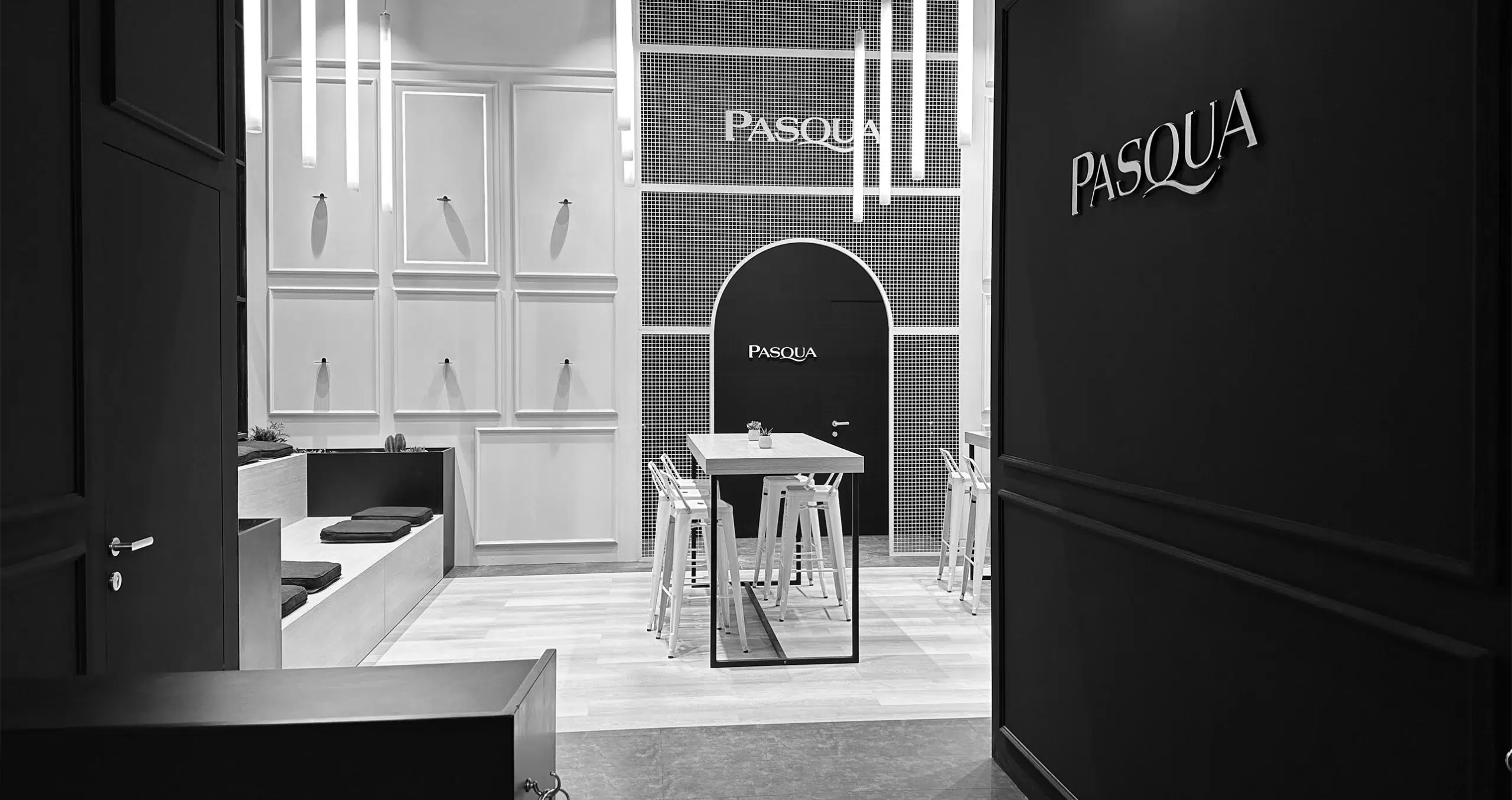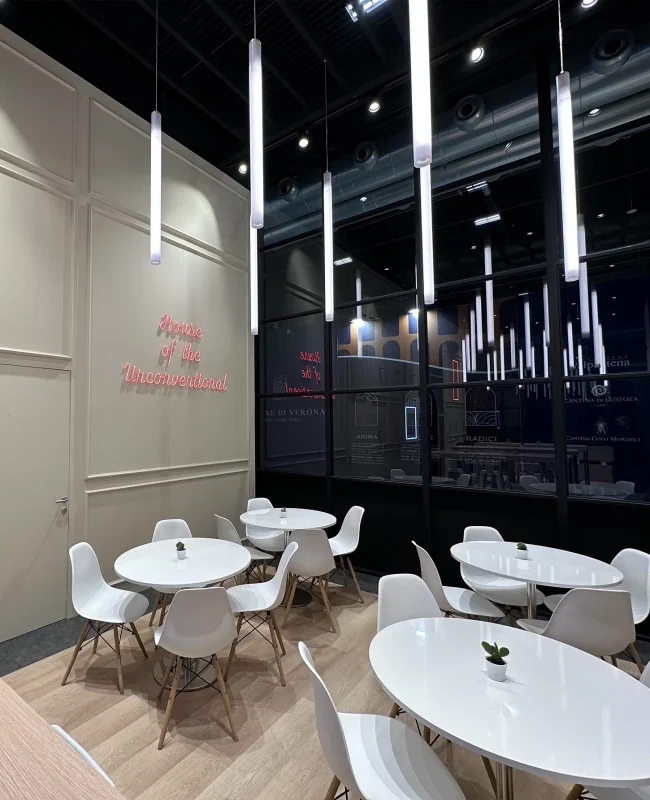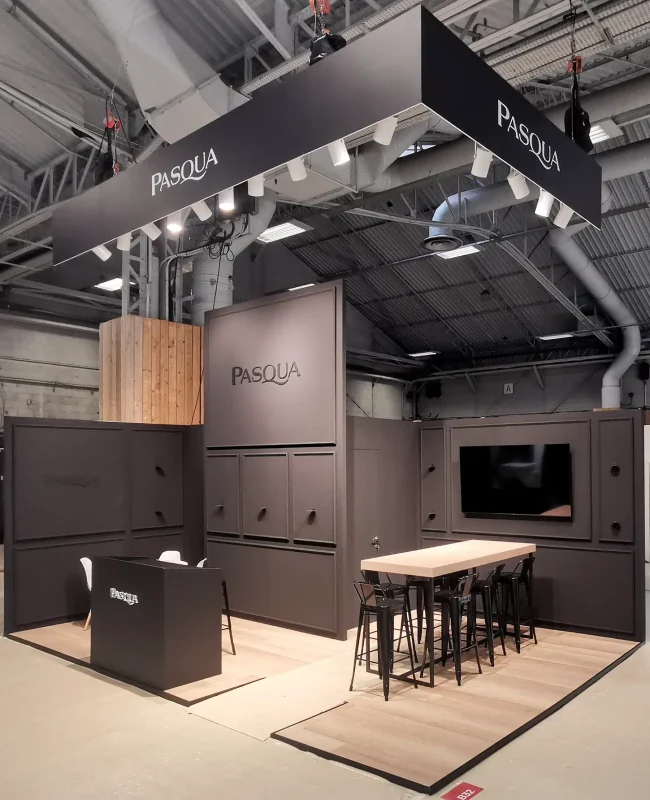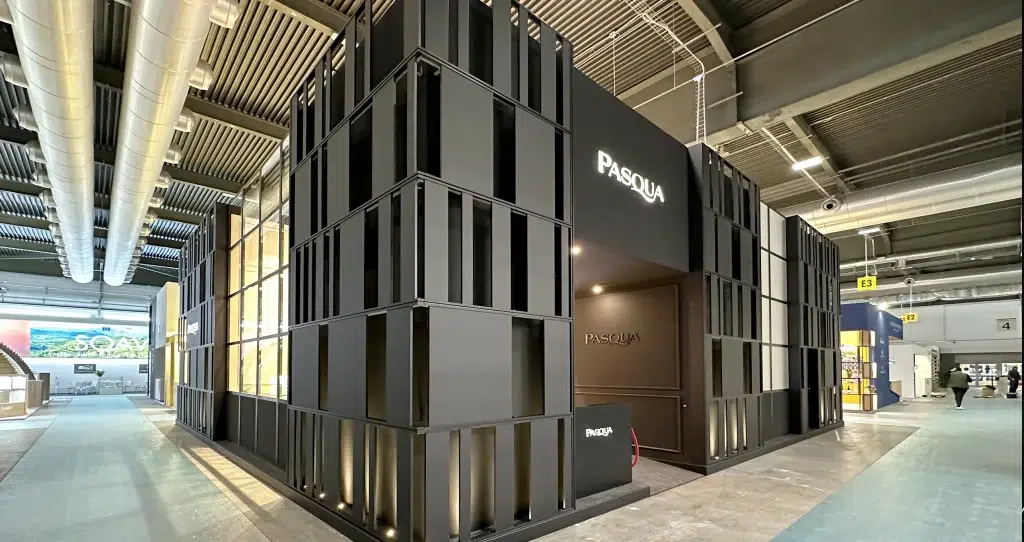Wine Paris 2026: when aesthetics become a key value in wine excellence – the Pasqua case

Why "setting up" is no longer enough
The change in visitor behavior
In the world of wine, the fair is no longer just a place to taste, but a space in which to live a cultural and aesthetic experience. Buyers, journalists and enthusiasts seek authenticity and visual language consistent with brand values. Events such as Wine Paris now represent the excellence of this approach: an international platform where art, design and wine culture meet.
From vision to experience: what brand leaders demand
Leading manufacturers know that a brand’s image also comes through the space in which it is presented. Outfitting has become a strategic positioning tool: communicates prestige, contemporaneity and quality even before the first goblet. In international fairs, aesthetics is the new language of value.
What Wine Paris represents on the international scene
An event symbolizing elegance and business
With over 40,000 trade visitors and more than 3,800 exhibitors, Wine Paris is now Europe’s most representative fair for oenology and international distribution. Every February, Paris becomes a meeting point where business, culture and lifestyle come together. In this context, trade show design is not simply set design, but vision and identity manifesto.
The value of aesthetic experience in the wine industry
In the world of wine, beauty is not just form, but substance. It is through design and experience that the public perceives the care, tradition and creativity that are hidden behind each bottle. A well-designed booth tells the story of wine as a culture, not a product.
Case study: Pasqua Wines - evolution of an exhibition identity


About Easter Vineyards and Cellars
Founded in 1925 in Verona, Easter is one of the most representative Italian wineries in the world. The company calls itself “House of the Unconventional”, a manifesto that sums up its philosophy: combining tradition and innovation, roots and experimentation.
Its roots go back to the Valpolicella, a territory from which it draws identity and quality, but the vision looks to the future: art, creativity and research are at the center of the business project. As stated by the Pasqua family: “We believe that creativity contains the seed of urgency that needs to be cultivated with love and care, just like the soil.”
Today Easter is recognized for its international vocation, with more than 80 percent of its sales generated abroad and an increasingly solid premium segment positioning. Its style combines elegance, innovation and contemporary italianity.

Project Objective.
For years Expo has been accompanying Easter in the design and implementation of its exhibition spaces at Vinitaly e Wine Paris, on a path of continuous evolution. The goal: visually convey the brand identity and its “unconventional” positioning through the language of space.
Each display is designed to embody the duality that characterizes Easter: solid roots and creative vision. Wine is the pretext for telling a story of design, art and conviviality.
Concept conception and development
Between Vinitaly 2022 and 2025, Easter’s exhibition concept underwent a radical transformation.
- 2022: A traditional space, orderly but still tied to classical codes.
- 2023: a new visual language is born: textural surfaces, warm lighting, essential geometries, and a cozy, contemporary atmosphere.
- 2025: the concept is consolidated and refined, maintaining recognizability and consistency.
For Wine Paris 2024 and 2025, the design was adapted to more compact spaces while preserving elegance and scenic impact. Every element – from the tasting counter to the wood paneling – was designed to transmit Italian warmth, elegance and authenticity.
Aesthetics as a positioning tool
In Easter stands, aesthetics is not decoration, but strategic value. Every design choice-from proportions to lighting-serves to build a consistent brand message.
Easter’s constant presence at Vinitaly and Wine Paris tells of a path of stylistic and identity maturation: the booth has become the physical translation of the claim House of the Unconventional, where every element communicates independence, research and style.
The 5 rules of design for the wine industry
Consistency with brand philosophy
The space should reflect the personality of the wine and the company’s values: elegance, innovation, hospitality.
Evocative materials and textures
Wood, stone, iron, warm light: matter becomes sensory language that tells about territory and tradition.
Integrated storytelling
Each area must be part of a story: from the labels to the tastings, everything must communicate vision.
Relational experience
Design should encourage encounters. Beauty invites conversation, generates trust and legitimizes brand value.
Continuity and recognizability
Changing trade fair or country, the booth must remain recognizable. Visual consistency is the key to premium positioning.
From design to strategy: the value of a design partner
When aesthetics becomes business
For wine brands, aesthetics is not a frill, but a experiential marketing lever. At events like Wine Paris, the booth communicates reliability, quality and style. The visual impact generates memory and strengthens the business relationship.
The role of Expositive
Espositiva translates the brands’ philosophy into coherent and engaging spaces. For Easter, it designed environments capable of Expressing the balance between roots and vision, enhancing aesthetic research as a tool for identity. From concept to realization, every detail is designed to represent Italian quality and soul in the world.
“We don’t build booths, but experiences. We tell about brands through spaces.” – Exhibition
Conclusions
Aesthetics as a competitive language
In the wine industry, where perceived value is paramount, aesthetics become the most immediate form of identity. Wine Paris 2026 will confirm this paradigm: the brands that can combine beauty and consistency will be the ones destined to remain in the memory.
The Easter case as an example of consistency and growth
From tradition to modernity, from the stands in Verona to those in Paris, Pasqua represents a model of evolution and fidelity to its vision. With the support of Espositiva, it has transformed the exhibition space into a Visual storytelling of value and identity: demonstrating that, in wine as in design, excellence is a matter of balance.
FAQ - Design and wine marketing
1. Why is design so important for a wine brand at a trade show?
Because it represents the brand’s first impression. A well-designed booth communicates elegance, quality and reliability, which are key elements in the premium wine market.
2. How does Wine Paris differ from other wine fairs?
It is the industry’s most international and contemporary fair: combining business, art and wine culture in one immersive and refined experience.
3. How does the philosophy of “House of the Unconventional” translate to Easter’s exhibition space?
Through natural materials, warm lighting and a welcoming design that reflects the brand’s dual soul: solid roots and creative vision.
4. What is the added value of Expositive’s work for Easter?
Exhibit interprets brand identity and transforms it into architecture: a consistent, elegant and recognizable space at every trade show.
5. What are the key characteristics of an effective booth in the wine world?
Consistency, elegance, relational experience, visual continuity and the ability to convey authenticity: the pillars of every Espositiva signature project.
With Espositiva, every space
becomes an extraordinary experience.